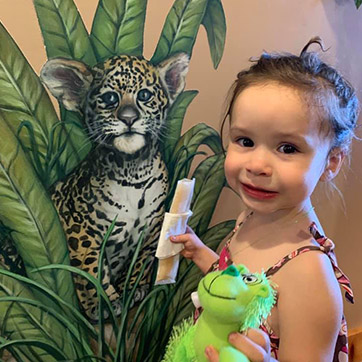
Pediatric Dentistry
Pediatric dentistry is a specialty of dentistry that requires two extra years of training after dental school. While most family dentists have treated between 10 and 15 children during their training, pediatric dentists treat over 3000 children before their training is complete. A pediatric dentist spends those two years learning that children are not just small adults- not only is the type of dental work different, but so is how you accomplish the care. We learn to treat patients as they mature, both physically and emotionally, from infants to young adults. The type of care and how it is approached varies from child to child and age to age, and our goal is to help our patients grow into young adults who value their oral health, have great routines in place and LOVE going to the dentist.
Getting Started
A child's first visit to the dentist should be enjoyable. Children are not born with a natural fear of the dentist, but they can fear the unknown. Our office makes a special effort to use pleasant, non-frightening, simple words to describe each treatment. We want you and your child to feel at ease from the moment your family arrives at our office. The more you and your child know about the first visit, the better you will feel.
The American Academy of Pediatric Dentistry recommends...
Children should visit the dentist by their first birthday. It is important that your child's newly-erupted teeth (erupting between six and 12 months of age) receive proper dental care and benefit from proper oral hygiene habits right from the beginning.
Getting to know your teeth is fun!
Download our Dynamite Dental Fun Kit!
When New Teeth Arrive
Your child's first primary or baby teeth will begin to erupt between the ages of six and 12 months, and will continue to erupt until about age three. During this time, your child's gums may feel tender and sore. To help alleviate this discomfort, we recommend that you soothe the gums by rubbing a clean finger or a cool, wet cloth across them. You may also choose to make use of a teething ring. When your child has finished teething, you can expect a total of 20 primary teeth.
Your child's primary teeth are shed at various times throughout childhood. Permanent teeth begin erupting at age six, and continue until age 12. Adults have 28 permanent teeth (32, including wisdom teeth).
Adopting Healthy Oral Hygiene Habits
As soon as your child's teeth erupt, it is time to start a good twice-daily brushing routine. Remember that sugary foods and liquids can attack a new tooth, so take care that brushing is always the last thing after eating or drinking anything before you put your child to bed.
Brushing can be fun, and your child should brush as soon as the first tooth arrives. When a baby's tooth erupts, parents should brush the tooth with a soft-bristled toothbrush and a small amount of training toothpaste. For children younger than two, do not use fluoride toothpaste unless advised to do so by your dentist or other healthcare professional.
Flossing is also a part of good oral hygiene habits, and your doctor will discuss with you the right time to start flossing. Flossing is improtat any time there are no longer spaces between the teeth for your toothbrush bristles to reach. For most children, the spaces between the teeth start closing around age four and a daily flossing routine should start.
Preventing Tooth Decay with Regular Checkups
Tooth decay is caused by sugars left in your mouth that turn into an acid, which can break down your teeth. Children are at high risk for tooth decay for a simple reason: many children and adolescents do not practice regular, good oral hygiene habits. Proper brushing and flossing routines combined with regular dental visits help keep tooth decay away.
Your child should visit the dentist every six months for regular dental cleanings and checkups. We recommend fluoride treatments twice a year along with cleanings to keep teeth their strongest. Tooth sealants are also recommended because they "seal" the deep grooves in your child's teeth, preventing decay from forming in these hard-to-reach areas.



 Website Powered by Sesame 24-7™
Website Powered by Sesame 24-7™